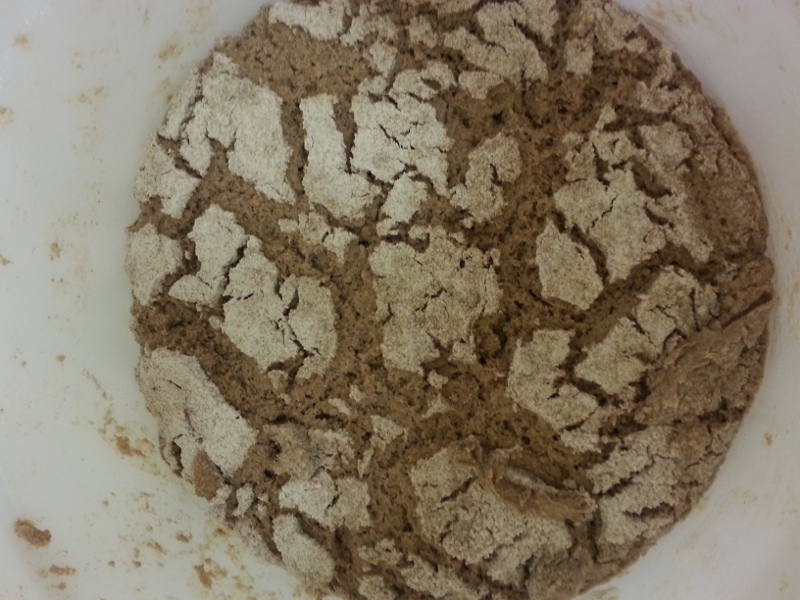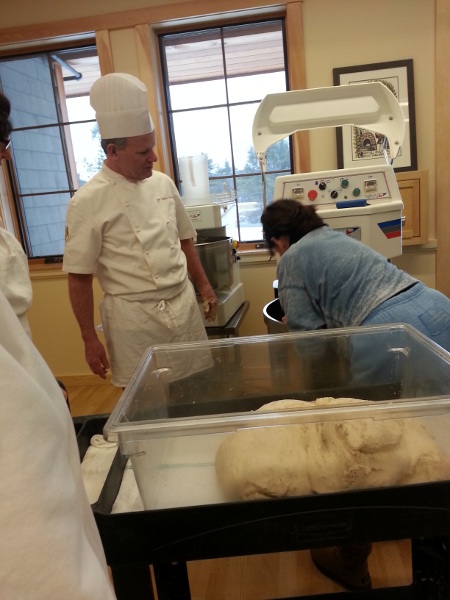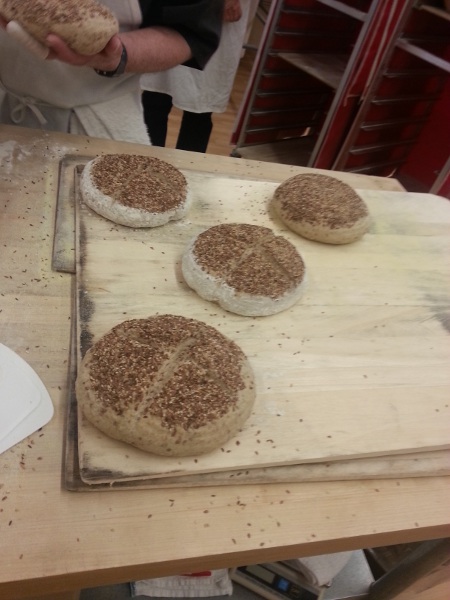This weekend, I and three other TFLers took a rye class at King Arthur with Jeffrey Hamelman. Larry - aka Wally - Faith in Virginia, and Otis - aka burntmyfingers - were there each driving from a different corner of the region. It was fantastic to meet them for once, knowing them only from their bread and words up to now. The class had 11 students (one didn't show up!) ranging in age and experience, with the one from furthest away hailing from Malibu, CA.
If I had any hopes in advance for the class, it would have been to gain a bit more skill in particular areas like mixing, shaping, slashing. I can safely say that I did not make even an inch of progress in any of these areas. That does not mean however, that I didn't learn anything. Here are the lessons I learned in the order that I think of them.
The most tangible lesson to come out of this class for me is that my rye starter needs work. The smell of the Hamelmanian rye starter is like nothing I've ever smelled before. Since of course we were dealing with large enough quantities of starter to make 25 large loaves of bread for each of the 4 formulas we made over the weekend the mass was much larger than anything I'd ever worked with. The smell was completely overpowering, and I had to move back a pace or two just to keep from keeling over. My rye starter, even with my nose right up to it, just cannot compare. This carried through all the way to the taste of the breads.
Chef Hamelman gave us a disquisition on the benefits of taking good care of our starters, explaining that extended refrigeration without feeding (mea culpa) leads to an acid buildup that in turn begins killing off the yeast and beneficial bacteria. While the King Arthur bakery feeds their wheat and rye starters twice a day, every day, he understood that might be tough for those of us who only bake once or twice a week, but he nevertheless suggested that we up our feeding schedule to at least a few meals per week. While I have been skeptical of this in the past, I am not anymore. In fact, if I could get the flavor in my breads that came out of the King Arthur classroom ovens yesterday, I would gladly feed twice a day no matter how much I had to throw out. Consider me converted at least in theory. We'll see what happens in practice.
Home bakers are at a disadvantage when it comes to equipment. Our loaves came out of the ovens with a sheen that I have never been able to achieve with my gas oven and various steaming techniques. One press of a button and the deck ovens filled magically with steam which was then vented at just the right moment. The spiral mixer just mixed the heck out of all the doughs while we all stood around with not much to do. What can we do about this? Be jealous. That's it.
Chef Hamelman spent a lot of time testing us on when things were done. Is the dough mixed enough? Proofed enough? Baked enough? He kept a poker face throughout, there were always divergent opinions, and most of us were wrong as often as right. What I did learn is that you can't just knock the bottom of a loaf to see if baking is done. He recommended squeezing, looking, etc. He did not pull out a probe thermometer and check. Glad of that as I fried mine awhile ago and haven't replaced it.
Peels with 8 or 9 loaves of bread on them are really heavy and getting them into the hot oven was too scary for me. I finally took a stab at removing a load, and that was bad enough. Chef Hamelman's assistant was a quite thin and small young woman who was originally a baker in the KA bakery, so some are made of sterner stuff than I. Other than that, the professional baking environment seemed much more manageable to me than I had imagined (see lesson about equipment above.)
Steam matters. I already knew this, but we had a great accidental demonstration. In addition to the 100 or so loaves that got made over the course of the two days, we also made a batch of salt sticks, and a batch of deli rye rolls. These were baked in the same oven as some 80% rye panned loaves - not a deck oven. They came out looking very inedible, as it turned out the steam wasn't hooked up to that oven much to Chef Hamelman's surprise. The loaves made of the same dough that were baked in the deck ovens were burnished and plump as could be. The 80% rye did fine however, as it was very wet, and had the protection of the pans.
Loaves made were a deli rye (best I've ever tasted) the 80% rye pan loaves, a flax seed rye, and a quark rye. We each came home with two of everything but the pan loaves and I immediately wrapped most of it up and froze. My husband who has always expressed an aversion to rye, has been chowing down on the flax seed loaf, and says it is the best loaf I've ever made. Well I didn't really make it in any sense other than shaping it. As my son put it, I paid a lot of money to find out just how much I have yet to learn (and he didn't say it quite as nicely as that.)
Final lesson: if you are going to depend on your phone for picture taking, you have to remember to take the charger.
Hope other participants will post themselves or add to this.
I sign off tired but happy.
-Varda
Update: Rod, a student in the class, kindly sent in his excellent pictures and descriptions for posting:

Jeffrey put whole rye flour on the top surface of the sourdough as much to pay homage to his German mentor and less for environmental control. In pursuit of tradition. This sourdough was developed after 16 hour at room temperature with a plastic wrap cover over the container.

From the French word gémir, to groan. The backbreaking work of the third year apprentice.

So few caraway seeds in the deli rye dough but the flavor was pronounced.

Never far from the mixer.

Applying flour to the outer edge for an artistic flare. It was recommended to perform this task while the dough was still moist and consider using niger seed for a more dramatic effect.

Here is a shot of the quark loaves. Remember how hot they were when we were attempting to determine if they were done. It was easier to compare the color in the loaves in the oven.

Fruits of our labor.